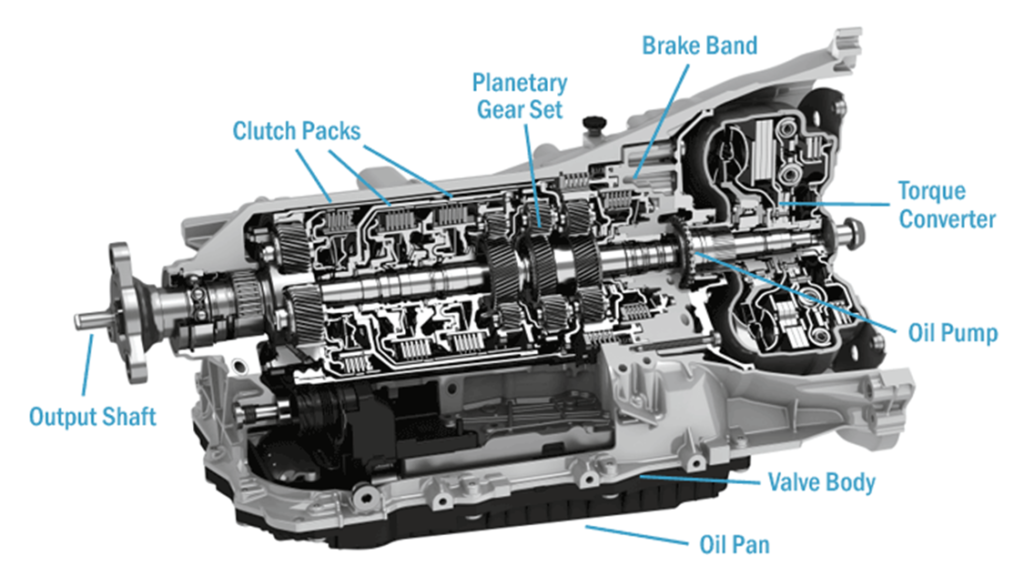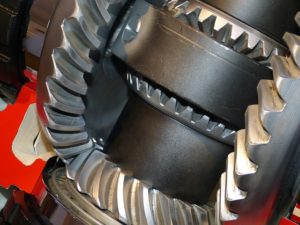
Rebuilt or Remanufactured Transmission Service
Elite Automotive Services knows your transmission is the last thing you have time to worry about. Our Transmission specialists make sure you leave our 30,000 state-of-the-art facilities with peace of mind knowing that your car received the best service, all at the right price!
If our initial diagnosis determines you need a transmission, you can be confident that the unit installed into your vehicle will provide years of dependable service. You’ll discover Elite Automotive Services is your most dependable solution. Whether one of our master builders rebuilds your transmission using only the highest quality replacement parts or whether we install a premier replacement transmission.
Rebuilt Transmission Service
When our master technician rebuilds your transmission, there’s no fear of a defective replacement unit. And because it is rebuilt using the original unit by our expert technician, you know it’s right! He’ll completely disassemble your transmission, rebuild it with quality parts, thoroughly clean and inspect your transmission’s internal and external components. Once your transmission is rebuilt, we will reinstall your transmission, refill the fluid, make any external adjustments, and road test your vehicle to ensure the transmission operates as designed. You get peace of mind that your transmission has been rebuilt to manufacturers’ exacting quality standards and backed with a three year/3,000-mile warranty.
Remanufacturing a Transmission
When searching online for a replacement transmission, most vehicle owners do not realize that there are many benefits to buying a remanufactured transmission. Remanufactured transmissions are nearly identical in performance to a new transmission. Therefore, no matter what you drive, we can offer you a superior product at an affordable price.
Benefits of a Remanufactured Transmission:
- Complete disassembly and inspection of a transmission
- Replacement of various overused parts with top-quality new transmission parts
- Original Equipment Manufacturer (OEM) updates for a like-new transmission
- Diagnostic testing of the remanufactured transmission before it installed in your vehicle
- Worn or damaged parts are replaced with OEM quality parts
- Any parts out of specification are machined back to OEM Specs
Once your unit is installed or reinstalled for both transmission replacement services, our expert technician will refill the fluid, make any necessary external adjustments, and road test your vehicle to ensure that the transmission operates as designed. You get peace of mind that your transmission has been rebuilt or replaced to exacting standards and backed by the industry’s best warranty.
Your car’s transmission is to ensure your car’s wheels are given the right amount of power to drive at a given speed. There are two types of transmissions, the automatic and the manual transmission, sometimes referred to as a “Clutch.” They both work differently, but they do perform the same function.

FREQUENTLY ASKED QUESTIONS
How Does a Manual Transmission Work?
A manual transmission works very similarly to a bicycle’s gear shift, even though there is no chain in your car. When you change gears in your bike, the chain lifts away from the gears; in your car pushing the clutch disconnects the engine and transmission, you move into a new gear and release the clutch to reconnect the two.
How Does an Automatic Transmission Work?
An automatic transmission is basically an automatic gear shift; instead of manually changing gears with a clutch, the car instead performs those actions for you. Vehicles begin to struggle at a lower or higher speed; the transmission and torque converter senses the change and shifts you into the appropriate gears, either up or down.
When Do I Change My Transmission Fluid?
Every car will be slightly different; some manufacturers recommend changing transmission fluids out as often as every 30,000 miles, others recommend waiting until reaching 100,000 miles. You should check your car’s owner’s manual for the recommended changing times or consult your trusted mechanic. If you pull heavy loads regularly, drive in stop-and-go traffic daily, or frequently push hard accelerations, you may have to check your fluid more regularly.
How Do I Check My Transmission Fluid?
Your car’s manual will explain whether you should have your vehicle running or not when checking your fluids. The transmission fluid dipstick is usually found under the hood, be sure not to confuse it with your oil dipstick. When you pull the stick out, if it is covered with fluid up to the indicator line, your fluid is full. You can wipe the dipstick and perform a second time for accuracy.
How to Add More Transmission Fluid?
If your fluid is low, you can always top it off. Do not overfill because that can damage the engine. If your fluid is low or in bad condition your mechanic can replace fluid, check for issues, and flush your system and replace what is necessary.
Why is My Transmission Fluid Pink?
Transmission fluid is dyed pink or red for easy visibility. The fluid should still be translucent and easy to see through. Dirt and visible dark colors in the fluid can indicate a problem; you should talk to your mechanic. He can’t rely on color alone, but it is an indicator of many transmission problems.
With proper maintenance, a transmission typically lasts you the lifetime of your car. However, when maintenance is neglected, transmission components get damaged in an accident, or for other unforeseen reasons, your transmission may expire prematurely. In this case, call Elite Automotive Services—we offer transmission service, repair, and replacement to our customers in Lake Forest and throughout Orange County. Contact us today to schedule an appointment for your transmission repair or maintenance.
Should I repair or replace my transmission?
Many of those who bring their vehicle into Elite Automotive Services for transmission service and repair are both surprised and relieved to learn that a problem with their vehicle’s transmission does not necessarily mean a lot of money needs to be spent to repair it. Several transmission problems can be solved without having to remove the transmission from a vehicle. Elite Automotive Services has put together the following information to make you a better-informed consumer when trying to decide if you should repair or replace your transmission. We also provide Transmission Inspections to determine the best solution for your particular situation.
How do I know if my transmission will need a minor repair?
The technicians at Elite Automotive Services understand that your vehicle’s transmission problems can often be resolved with adjustments or a minor repair. A simple adjustment can be made without even removing the transmission from the vehicle. When a late model transmission fails to shift correctly, it can often be due to a faulty sensor receiving incorrect signals from the computer. Additionally, shifting problems can arise when a transmission is not responding to the computer correctly due to a bad connection or defective solenoid pack. These repairs can be fixed without having to remove the transmission from the vehicle, saving you a considerable amount of money compared to a complete overhaul.
Will my non-computer-controlled transmission need repair?
If a non-computer-controlled transmission is either shifting too early or too late, the throttle cable may need to be adjusted. Rarely will a throttle cable go out of adjustment on its own or because of wear and tear, but rather most issues result from other repair work or due to damage from an accident? When a vacuum modulator is used instead of a throttle cable, an adjustment screw can correct a transmission problem. When a vehicle uses a modulator instead of a throttle cable, there must be no vacuum leaks, and the engine is performing at peak efficiency. The vacuum conditions of an engine are susceptible and significantly impact the performance of an engine. Elite Automotive Services technicians will often use a vacuum gauge to diagnose a vehicle’s performance problem and state of tune.
Is my transmission slipping?
Many of the problems a vehicle’s transmission may present will disappear after a thorough tune-up, or other engine performance-related repairs are completed. Transmissions in older model vehicles can experience what is called “slipping.” Slipping is a condition that results in an engine racing briefly when shifting from one gear to another. Often a transmission band adjustment is all that is required to correct slipping conditions.
Does my transmission need to be resealed?
Spotting red oil on the ground underneath your vehicle usually indicates your transmission needing a reseal job. Reseals are done to repair external transmission fluid leaks. Checking for leaks involves one of our technicians placing your vehicle on a rack to examine the transmission for signs of oil leaks. Suppose, while inspecting your vehicle, our technician notices leaks near any of the external gaskets or seals, and your transmission is otherwise performing well. In that case, our recommendation will usually the transmission be resealed. While most external seals can be replaced without needing to remove the transmission, a front seal replacement requires removing the transmission to gain access to it, resulting in a more expensive transmission repair.
Do I need replacement parts for my transmission?
The transmission in your vehicle has numerous parts that are accessible without requiring the removal of your transmission, including the majority of the electrical components that are serviced simply by removing the oil pan. Repairing a transmission’s external parts may result in limited warranty coverage. It is impossible to see if there are any additional problems with the transmission components that are only accessible with the complete removal of the transmission.
What is a transmission overhaul?
A complete transmission overhaul, also known as a transmission rebuild, is when a transmission is completely removed from the vehicle and disassembled in our shop. Each of the parts is laid out on a workbench and is inspected for damage and wear. The parts are then either cleaned in a particular cleaning solution or replaced if damaged. If a part has friction surfaces, such as the case with bands and clutches, it is replaced. In a complete transmission overhaul, all gaskets and seals are replaced as well. The torque converter is replaced during a complete transmission overhaul, being replaced with a remanufactured one. Additionally, our technicians will review technical service notifications to check if the manufacturer of the transmission in question recommends any modifications intended to correct design defects realized after the transmission was built.
Should I rebuild or replace my transmission?
When it is determined that your vehicle’s transmission needs an overhaul, a replacement unit may be considered. Rather than removing your existing transmission only to disassemble and reassemble it completely, another option is to replace it with one that has already been rebuilt or remanufactured. There are several things to consider when deciding to use a replacement unit instead of a complete transmission rebuild. Although a replacement unit will get you back on the road much faster, it is not always the best solution. There are situations when any given transmission model will have numerous variations depending upon which model vehicle, engine, axle ratio, and even tire size!
How do I tell if my transmission fluid needs to be changed?
Your transmission will show signs of trouble. Things such as trouble going into gear, hard shifts or thumps between gears, slipping or jumping gears, delay in acceleration, and strange noises such as whining or grinding are all signs it’s time to change the transmission fluid. The transmission fluid color is an excellent visual way to estimate the fluid’s age and condition and get an idea of any more significant problems. Read more about your transmission, transmission fluid, and how to know if something is wrong.
How many times can a transmission be rebuilt?
This will depend on which parts in your transmission have failed, how extensive the damage is, and how much money you are willing to spend on parts vs. a new car. Learn more about rebuilding vs. replacing a transmission.

